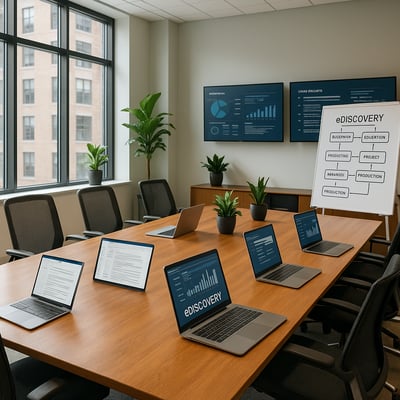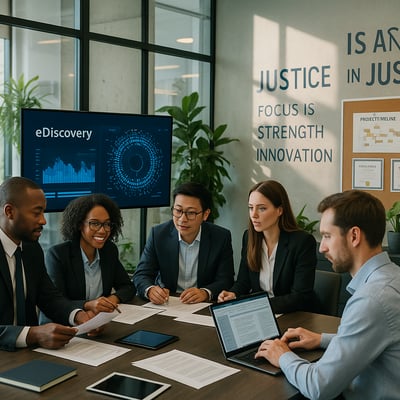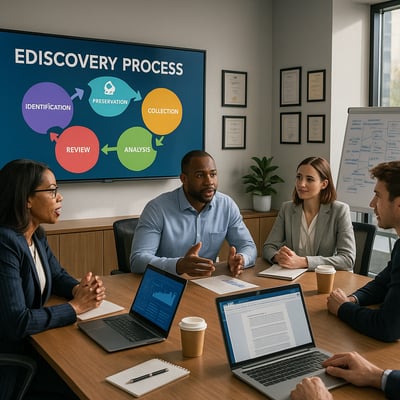" Cut Through the Digital Clutter: Why eDiscovery Is No Longer Optional \n In today’s legal...

Every week, the Array team reviews the latest news and analysis about the evolving field of eDiscovery to bring you the topics and trends you need to know. This week’s post covers the week of March 25-31. Here’s what’s happening.
LegalTech News covered the case of Andrea Jo Anne David-Vega, a Georgia lawyer who was disbarred for this egregious eDiscovery violation: putting a fake email into evidence.
According to the article, David-Vega maintained a heavy caseload for the Georgia Department of Family and Child Services in addition to private practice cases. Those cases included a personal injury matter for a client whose brain was injured in a vehicle crash; however, she missed the statute of limitations deadline to file the case. After her client filed a bar complaint, David-Vega produced an email that made it appear her client had terminated her representation before the deadline passed. But the bar found the email was written in a different font and contained perfect “diction, capitalization, and punctuation,” unlike other emails from the client.
In determining sanctions, a special master said David-Vega’s workload, ill parents and ADHD and anxiety diagnoses were mitigating factors and, along with the state bar, recommended a two-year suspension. The Georgia Supreme Court disagreed and disbarred David-Vega, writing “her fabrication of evidence during the underlying disciplinary proceeding and in the malpractice case against her implicate some of the most serious violations under the Rules, and that severe discipline is warranted.”
On his Ball In Your Court blog, Craig Ball argued some parties have been “getting away with murder” by refusing to produce linked attachments because they are an undue burden. Ball’s post provides an explainer and historical overview of linked attachments and why they are such a “fuss.”
With many companies and organizations using Google Workplace or other cloud-based solutions, employees often choose to link to files stored elsewhere on the network in email messages rather than embed them or include as a traditional file attachment. While the intent is often the same – the sender wants the recipient to have access to the information contained in the link – sending a linked attachment necessitates a different eDiscovery collection procedure than for embedded or attached files because the linked files aren’t physically part of the parent email.
As Ball wrote, emails can be indexed and searched and when attachments are embedded in email messages, those attachments can be indexed and searched. But if attachments are linked, they must be downloaded with the associated message before emails are indexed and searched, otherwise the linked attachments won’t be part of a “family relationship” that can be searched. Instead of choosing that workflow, however, a producer can simply ignore linked attachments and only produce an index of emails and attached files.
While not perfect, Ball said, Microsoft and Google have tools for collecting linked attachments and courts should “stop giving a free pass to the practice of ignoring linked attachments. … (they) have been around for years, and they are evidence. Waiting until the crisis stage to begin thinking about how to deal with them was a choice, and a poor one.”
Some tips on collecting linked attachments:
On Medium, Kelli Radnothy shared her four essential skills for paralegals to excel in eDiscovery. In addition to adapting to evolving technology, problem solving, and critical thinking, she includes strategic planning. “Meticulous planning is essential,” she writes. “Not only to mitigate risks, but also to ensure compliance with court requirements.” As the old adage goes: if you fail to plan, you plan to fail. Read the entire post here.
Other recent eDiscovery news and headlines:
With a decade of expertise, Julia excels at optimizing enterprise eDiscovery workflows from start to finish. With a deep understanding of how to seamlessly integrate workflows across various eDiscovery platforms, Julia creates tailored solutions for data identification, legal holds, ESI collections, and productions. By harnessing the power of Technology Assisted Review and Analytics, she delivers efficient, cost-effective results that align with best practices and budgetary constraints. Julia’s exceptional communication and customer service skills have fostered strong, lasting relationships with both clients and Project Management teams, enabling her to effectively problem-solve and drive success across numerous projects.

" Cut Through the Digital Clutter: Why eDiscovery Is No Longer Optional \n In today’s legal...



Every week, the Array team reviews the latest news and analysis about the evolving field of...